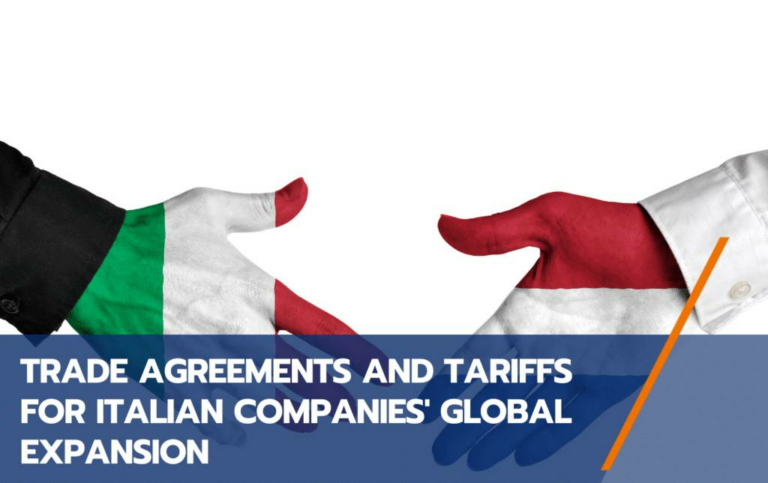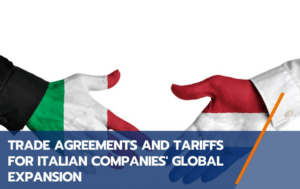International expansion offers a host of opportunities for Italian companies, from accessing new markets and diversifying revenue streams to strengthening brand recognition. However, businesses venturing abroad must carefully navigate the complex world of trade agreements and tariffs. Understanding these aspects is essential for reducing costs, optimizing supply chains, and ensuring compliance. This article provides an overview of key trade agreements and tariff considerations that Italian companies need to be aware of when expanding internationally.
Importance of Trade Agreements
Trade agreements are formal accords between two or more nations that establish guidelines for the exchange of goods and services. They aim to:
- Lower Trade Barriers: Reduce or eliminate tariffs, quotas, and import/export restrictions.
- Ensure Fair Competition: Create a level playing field through intellectual property protection, anti-dumping rules, and standardized practices.
- Facilitate Market Access: Provide predictable frameworks that businesses can rely on to establish cross-border trade relationships.
Key Trade Agreements Impacting Italian Companies
1. European Union Customs Union
- Overview: The EU Customs Union ensures the free movement of goods among EU member states, eliminating tariffs and customs duties for intra-EU trade. It also applies a common external tariff for non-EU goods.
- Implications: Italian companies trading within the EU benefit from reduced paperwork and streamlined customs procedures.
2. European Economic Area (EEA) and Switzerland
- EEA: The EEA includes EU member states and three European Free Trade Association (EFTA) countries: Norway, Iceland, and Liechtenstein. Goods flow freely within this area with minimal regulatory barriers.
- Switzerland: Switzerland, although not part of the EEA, has bilateral agreements with the EU, enabling relatively frictionless trade.
3. Comprehensive Economic and Trade Agreement (CETA)
- Overview: CETA is an EU-Canada trade agreement that eliminates most tariffs and reduces non-tariff barriers. It provides preferential market access for both goods and services.
- Implications: Italian businesses can export to Canada with reduced tariffs and faster customs processing.
4. EU-Japan Economic Partnership Agreement (EPA)
- Overview: The EU-Japan EPA removes nearly all tariffs on trade between the EU and Japan, promoting mutual investment and regulatory cooperation.
- Implications: Italian companies exporting machinery, fashion, or agricultural products to Japan benefit significantly from the agreement.
5. EU-Mercosur Agreement
- Overview: Although not fully ratified, this agreement between the EU and Mercosur countries (Argentina, Brazil, Paraguay, and Uruguay) aims to eliminate tariffs on over 90% of goods traded between the regions.
- Implications: Italian companies will gain greater access to these South American markets once the agreement is implemented.
6. EU-South Korea Free Trade Agreement
- Overview: The EU-South Korea FTA has been in effect since 2011, making South Korea one of the EU’s largest trading partners in Asia. It eliminates tariffs on nearly all goods and simplifies non-tariff measures.
- Implications: Italian exporters benefit from easier access to South Korea’s high-value markets, particularly in automotive, machinery, and food sectors.
Tariff Considerations
Understanding Tariff Structures
Tariffs are taxes imposed on imported goods. They vary based on:
- Product Classification: Every product is classified according to the Harmonized System (HS) code, which determines applicable tariff rates.
- Country of Origin: Tariffs often depend on the trade relationship between the exporting and importing countries.
Strategies for Managing Tariffs
- Leverage Trade Agreements: Verify if your target market has a preferential trade agreement with Italy or the EU to benefit from reduced or zero tariffs.
- Optimize Supply Chains: Establish manufacturing, sourcing, or assembly operations in tariff-friendly regions.
- Apply for Tariff Exemptions: In some cases, companies can apply for tariff exemptions if their products meet specific criteria or are not available locally.
- Diversify Export Markets: Avoid over-reliance on markets with high tariff rates by identifying alternative export destinations.
Non-Tariff Barriers
Italian companies should also be mindful of non-tariff barriers, including:
- Technical Standards: Ensure compliance with safety, health, and environmental standards in target markets.
- Import Quotas: Some countries limit the quantity of certain products that can be imported.
- Customs Delays: Lengthy customs procedures can disrupt supply chains and increase costs.
Navigating trade agreements and tariffs is crucial for Italian companies looking to expand internationally. By understanding the various trade agreements in place and proactively managing tariff structures, businesses can reduce costs, streamline operations, and access new markets more effectively. Italian companies should invest in thorough research and seek expert advice to maximize the benefits of international expansion while minimizing trade barriers.








